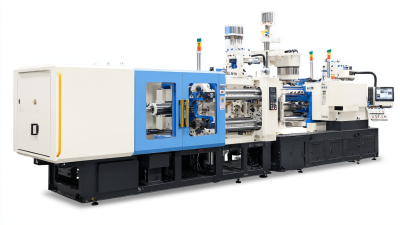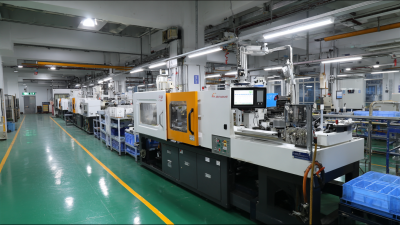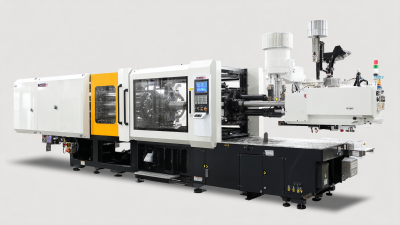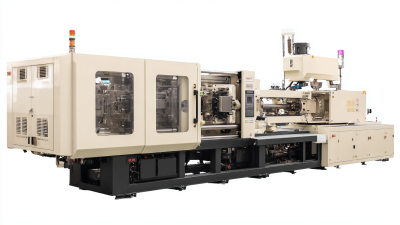Addressing Common Challenges with Small Plastic Molding Machines in Production
The use of small plastic molding machines in production has gained significant traction in recent years, particularly as manufacturers seek to enhance efficiency and reduce costs in an increasingly competitive market. According to a report by MarketsandMarkets, the global injection molding machine market is expected to reach $20.5 billion by 2026, with a notable rise in demand for smaller machines that can accommodate rapid prototyping and low-volume production. These machines not only facilitate quicker turnaround times, but they also support the diversification of product offerings.

However, as compelling as the advantages are, operators often encounter various challenges, including issues related to precision, material handling, and machinery maintenance. In this blog, we will explore these common challenges associated with small plastic molding machines and provide strategies for overcoming them to optimize production efficacy.
Identifying Key Production Challenges with Small Plastic Molding Machines
 Small plastic molding machines have transformed production lines by offering flexibility and efficiency, but they are not without their challenges. One of the primary hurdles is ensuring uniformity in product quality. Variations in temperature, pressure, and material composition can lead to defects in molds, resulting in wasted resources and increased production time. Addressing these inconsistencies requires regular monitoring and adjustment, making skilled operators essential to maintain optimal machine performance.
Small plastic molding machines have transformed production lines by offering flexibility and efficiency, but they are not without their challenges. One of the primary hurdles is ensuring uniformity in product quality. Variations in temperature, pressure, and material composition can lead to defects in molds, resulting in wasted resources and increased production time. Addressing these inconsistencies requires regular monitoring and adjustment, making skilled operators essential to maintain optimal machine performance.
Another significant challenge is the limited production capacity of small molding machines. While they are ideal for small runs or prototypes, scaling up for larger production can strain these machines, leading to bottlenecks. Manufacturers often struggle with balancing the demand for large volumes against the machine's capabilities. Implementing automated systems or integrating multiple machines can mitigate these issues, allowing for more efficient production workflows while still leveraging the advantages of small plastic molding technologies.
Analyzing Cost-Effectiveness: ROI in Small-Scale Plastic Production
In the realm of small-scale plastic production, understanding the cost-effectiveness of small plastic molding machines is crucial for optimizing financial performance. A report from the Plastics Industry Association indicates that nearly 30% of small manufacturers are currently investing in upgraded molding technology to enhance efficiency and reduce production times. The ROI for these investments can be significant, with data suggesting an average payback period of just 12 to 18 months, depending on operational scale and machine utilization. This rapid return is pivotal for smaller companies that must maintain competitive pricing while ensuring sustainable practices.

Furthermore, the flexibility of small plastic molding machines allows manufacturers to adapt to changing market demands, which is vital in today's fast-paced industry. According to a study by Grand View Research, the global small plastic parts market is projected to reach $2.5 billion by 2027, growing at a CAGR of 5.3%. This growth underscores the importance of adopting cost-effective solutions for production, enabling companies to not only meet customer demands but also capitalize on new market opportunities efficiently. By focusing on the cost-effectiveness of their operations, small manufacturers can significantly enhance their profitability and market position.
Understanding Cycle Time Impacts on Efficiency and Productivity
Cycle time is a critical factor that significantly influences the efficiency and productivity of small plastic molding machines. According to a report by the International Society of Plastic Engineers, optimizing cycle time can increase production throughput by up to 30%. This improvement directly correlates to reduced costs and enhanced competitiveness in the fast-paced manufacturing landscape. Achieving shorter cycle times not only streamlines operations but also minimizes the wear and tear on machinery, leading to lower maintenance costs and extended machine life.
To effectively tackle cycle time challenges, manufacturers can employ several strategies. First, investing in advanced mold designs, which incorporate features like improved cooling channels, can expedite the cooling process and shorten cycle times. Secondly, regular maintenance schedules should be established to ensure machinery is functioning at peak efficiency, preventing delays caused by unforeseen breakdowns.
**Tips:**
- Consider integrating automation solutions to streamline the loading and unloading processes, thereby reducing waiting times.
- Conduct regular training sessions for operators to enhance their skills in quickly troubleshooting and addressing minor issues that could lead to production delays.
By focusing on cycle time improvements and implementing these practical tips, manufacturers can enhance their overall productivity while addressing common challenges tied to small plastic molding machines.
Cycle Time Impacts on Efficiency and Productivity in Small Plastic Molding Machines
This chart illustrates the average cycle time and its impact on production efficiency for small plastic molding machines. The data represents the average cycle times (in seconds) and the corresponding efficiency percentages for different production volumes.
Quality Control Standards for Small Plastic Molding: A Necessity for Success
Quality control is crucial in the realm of small plastic molding production, as it ensures that products meet both consumer expectations and regulatory standards. With divergent views on product quality between corporate executives and consumers, implementing rigorous quality control standards can bridge this gap. When it comes to small plastic molding machines, consistent monitoring of the process can help to mitigate defects and improve reliability. This includes regular calibration of machinery, use of high-quality raw materials, and thorough inspections of finished products.
**Tips for Quality Assurance:**
1. **Implement a Testing Protocol:** Regularly conduct quality assurance tests throughout the production process. This will help identify any inconsistencies early, allowing for prompt corrective actions.
2. **Train Your Workforce:** Ensure that all employees involved in production understand the importance of quality control. Continuous training can empower them to spot potential issues before they escalate.
Additionally, the environmental impact of plastics cannot be understated. As the sector evolves, incorporating sustainable practices and recycled materials is also becoming a standard for quality. By adhering to these quality control standards, producers of small plastic parts not only enhance their products but also contribute to addressing the environmental challenges posed by plastic waste.
Addressing Common Challenges with Small Plastic Molding Machines in Production - Quality Control Standards for Small Plastic Molding: A Necessity for Success
| Challenge | Description | Impact on Production | Quality Control Standard | Recommended Solution |
|---|---|---|---|---|
| Material Variability | Inconsistencies in raw material quality can lead to defects. | Increased waste and rejected parts. | ASTM D638 | Implement a strict supplier quality audit process. |
| Temperature Control | Improper temperature settings can affect melt flow and solidification. | Poor surface finish and dimensional inaccuracies. | ISO 9001 | Regular calibration of temperature sensors. |
| Machinery Maintenance | Neglecting machine upkeep can lead to malfunctions. | Downtime and production delays. | ISO 13485 | Establish a routine maintenance schedule. |
| Operator Training | Lack of skilled operators can lead to errors in setup or operation. | Inconsistent product quality and increased defect rates. | ISO 29990 | Implement comprehensive training programs. |
| Process Monitoring | Failure to monitor key process variables can result in defects. | Increased scrap rates and rework costs. | ISO 9001 | Use automated systems for real-time monitoring. |
Leveraging Technological Advancements to Overcome Production Limitations
In the world of small plastic molding machines, technological advancements are pivotal in addressing common production challenges. These machines often face limitations such as decreased efficiency and inconsistent output. However, by integrating modern technologies, manufacturers can significantly enhance their operational capabilities. For instance, the adoption of advanced sensors and automation systems allows for real-time monitoring of production processes, ensuring that any anomalies are promptly detected and corrected.
Tip: Invest in upgrading your machinery with IoT capabilities. This integration not only provides valuable data insights but also streamlines maintenance schedules, leading to reduced downtime and higher productivity levels.
Moreover, software solutions that employ predictive analytics can forecast potential failures and optimize the production schedule, providing an edge in today's competitive market. By leveraging these technological tools, manufacturers can better manage their production lines and minimize waste.
Tip: Regularly train your workforce on new technologies and software. A skilled team is essential for maximizing the benefits of advanced machinery and ensuring smooth operation in production.
Related Posts
-

Global Quality Revolution How Chinese Moulding Plastic Machines Capture International Markets
-

Exploring Innovative Alternatives to Plastic Injection Machines for Modern Manufacturing
-

How to Choose the Best Home Plastic Injection Molding Machine for Your DIY Projects
-

Evaluating the Best Large Injection Molding Machines for Global Buyers in 2025 Industry Trends and Insights
-

Maximizing Production Efficiency with Advanced Plastic Molding Machines
-

Exploring the Comparative Benefits of Different Injection Molding Machine Types
